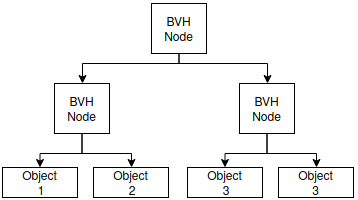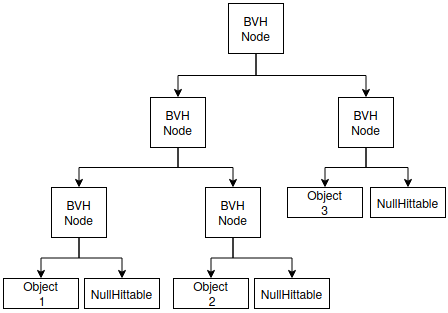Been a while since I've been in the BVH code, but your comment about ordering the left and right is a good one, particularly since the axis is chosen randomly (int axis = random_int(0,2)). Certainly worth making the changes you suggest here and seeing if there are problems. Nothing's jumping out at me right now.
On the null hittable, I think it would be better to construct a single public static member in the empty_hittable class, and then every use should simply grab a reference to that single instance. Like empty_hittable::instance. The advantages are that (1) everything that uses it should just reference a single canonical instance, and (2) it's more an aspect of hittable objects than it is of BVH nodes.
Ironically, three days ago I would have suggested a non-abstract hittable class with default implementations to effectively be an empty hittable, and then let other classes inherit from that. However, I've recently read that the idea that classes should either be abstract or should be concrete and final. That is, they should either be something you only inherit from, or something that is complete in itself that nothing else inherits from. I have to confess that I'm still trying to get my head around that, but this is exactly the situation that many are warning of. Old dog, new tricks.
For now, I'd like to see some concrete timing results of such a change, and I keep a running log of performance as the code evolves. Please create an experimental branch off dev-major to get the latest version, and let us know when you're ready for us to play with hit (typo, but I have to leave it in).
Related: (https://github.com/RayTracing/raytracing.github.io/issues/804)
In the BVH code, the leaf nodes aren't placed in an AABB containing just one object when
object_span==2. For the case of ray-sphere intersection, not placing the leaf nodes in AABBs improves performance slightly but, for more complicated ray-intersection tests, the AABB rejection can be very useful.*Note: In the figures below, BVH nodes perform the hit test with AABB and objects perform arbitrary hit tests. Before:
After:
Proposal to change this section of code in
BVHNodeconstructor:Add this class to
Hittable.h(Null object pattern)I make the dummy a static const member of the BVH Node class to make sure only one dummy exists and cannot be changed.
static const std::shared_ptr<Hittable> dummy;and then in theBVHNode.cppI add to initialise it:This solution is cleaner and faster than performing the bounding_box collision test in, for example the Sphere::hit function, as each Hittable::hit child would be responsible to perform its own coarse collision first (error prone and code duplication).
Secondly, the
left->hitright->hitcode can be left in tact with no conditionals and the dummy just returnsfalseinstead of performing the collision test on the same object twice, which depending on the complexity of the object can be slow. I agree with @trevordblack (https://github.com/RayTracing/raytracing.github.io/issues/804) that branch code should be avoided but not that this is a non-issue, from my tests with optimisations turned on-O3and a pseudo complex hit test. Return value caching would add more complexity than this approach and may lead to bugs and would be slower.Additionally, is the sorting even necessary in the case
(object_span == 2)since right->hit is always called after left->hit.If you would like, I could create a pull request for this according to book's code style? My current implementation differs from that in the book and would need to be modified to fit the book's style.